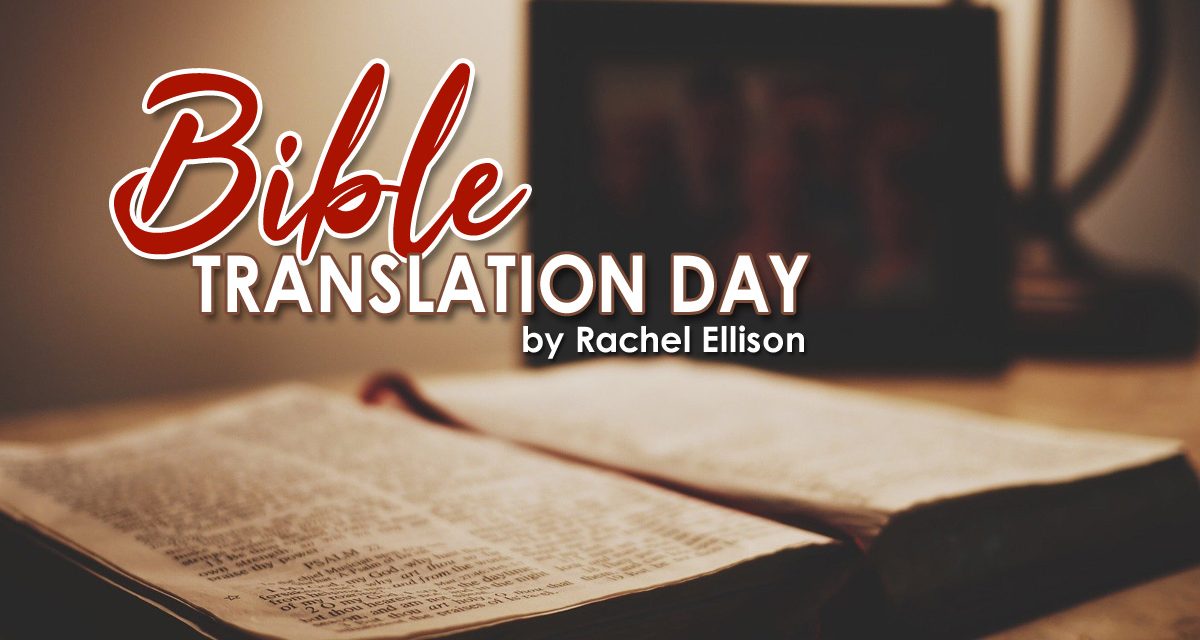September 30th is Bible Translation Day! This day is particularly meaningful to me because I grew up listening to my mom read missionary biographies as part of our homeschooling. I enjoyed hearing stories about the perseverance of Bible translators and the joy of people hearing God’s Word in their own language for the first time. These powerful influences eventually helped to inspire me to pursue the work of Bible translation and I am now headed into this field, so I’m excited to tell you more about this special day!
As a celebration of the many Bible translations that have been completed over the years, Bible Translation Day is a reminder of the wonderful gift of God’s Word and the privilege it is to be able to read it in our own language. This day has been recognized since 1966 and is celebrated on the feast day of St. Jerome, who translated the Latin Vulgate. Here are some fun ways you can incorporate Bible Translation Day into your school day!
Understand the History
Originally, the Bible was written in Hebrew, Greek, and Aramaic. As Christianity grew, Latin became the common language that most people spoke, so Jerome, one of the best Christian scholars of the time, translated the Latin Vulgate in 405. Vulgate means “common version” in Latin. As time went on, Latin switched from being the common language to being the language of the educated, which made it difficult for most people to read the Bible. In the 1300s, John Wycliffe firmly believed that ordinary people should have access to God’s Word, so he translated the Bible from the Vulgate into English and was later condemned as a heretic for it.
During the Reformation, William Tyndale worked to translate the Bible into English from the original Hebrew and Greek, for which he was burned at the stake. Martin Luther was convinced that every Christian should be able to read the Bible for themselves, so he translated it into his own language of German. In 1604, King James of England commissioned a translation of the Bible into English, which was finished in 1611 and is known as the King James Version. Since then, the Bible has been translated into English many times, and we now have a wealth of great translations to choose from.
Global Bible translation took off much more recently. In 1917, Cameron Townsend was selling Spanish Bibles in Guatemala when he encountered the Cakchiquel people. These people could not understand Spanish, but Cam wanted them to be able to read God’s Word. He spent the next ten years learning their language and translating the New Testament into Cakchiquel. He realized there were many more people around the world who did not have access to the Bible in their own languages, so he went on to found Wycliffe Bible Translators in 1942 to carry out Bible translation worldwide.
Today, many Bible translation organizations are working all over the world. According to the Wycliffe Global Alliance, 7,353 total languages are used in the world today, and out of those languages, 698 have a complete translation of the Bible. Another 2,686 have some parts of Scripture. The remaining 3,969 languages are still without any translated passages of the Bible.
Explore Translations
It’s fun to read translations of the Bible in a language you are learning or a language similar to English (like a pidgin language). My personal favorite is Da Jesus Book in Hawaii Pidgin because it is close enough to English that I can make it out, but it’s still noticeably different. I have found that reading the Bible in a language like Hawaii Pidgin causes me to notice details that I missed before, and it gives me a new appreciation for my English translations. Reading a translation in a language you are studying is great language practice. It’s also a great reminder to be thankful that you don’t need to master that language before you can understand God’s Word. Next time you read the Bible on your own or with your kids, consider trying out another language!
Encourage Missionaries
Encouragement is always welcome. Many missionaries and Bible translators are doing hard things far away from their families and friends, which means they need extra encouragement. If you know any missionaries, I’m sure they would love to receive a letter from you or your kids! Just getting a piece of mail or an email would be an encouragement to them, because it’s nice to know that people in your home country are thinking of you, praying for you, and wishing you well. If you need some ideas about what to write to a missionary, some great resources are available online.
Read the Stories
Missionaries and Bible translators often have wonderful, inspiring stories to tell! Some of my fondest memories from homeschooling involve listening to missionary biographies and hearing their fascinating stories about experiencing different cultures, persevering through trials, and encountering the power and goodness of God as they took His Word to the nations. I love hearing the true stories of translations that were accomplished in difficult areas against all odds, and the joy that it brings to people as they experience God’s Word. If you want to learn more about other cultures and be inspired by the faithfulness, courage, and Christ-honoring exploits of many who have gone before us, then I strongly encourage you to pick up a missionary biography!
Relevant Products
000892 Cameron Townsend (Christian Heroes Then & Now)
065601 Sword of the Spirit: Tyndale
062897 Around the World with Kate & Mack: Look at Languages from A to Z
004434 The Missionaries’ Coloring Book





